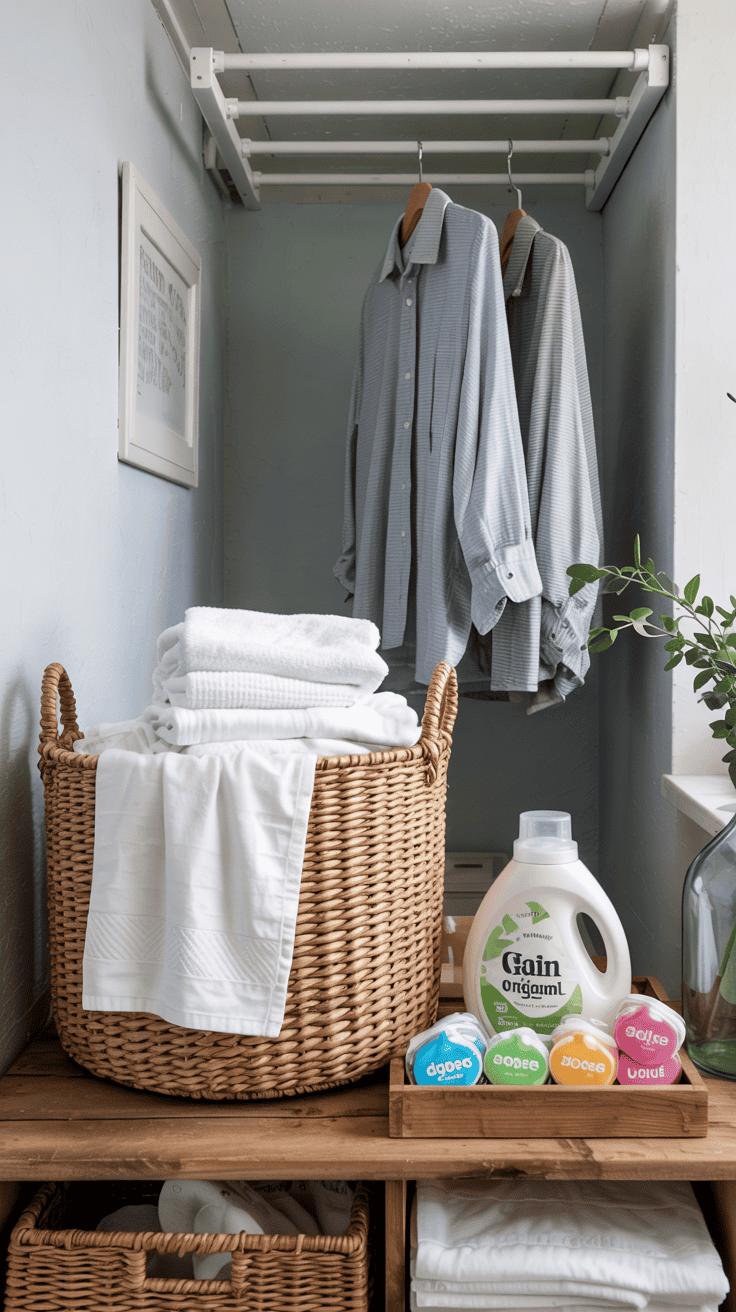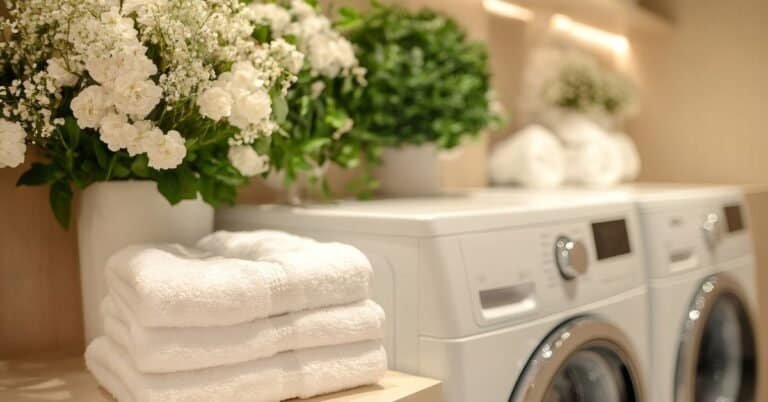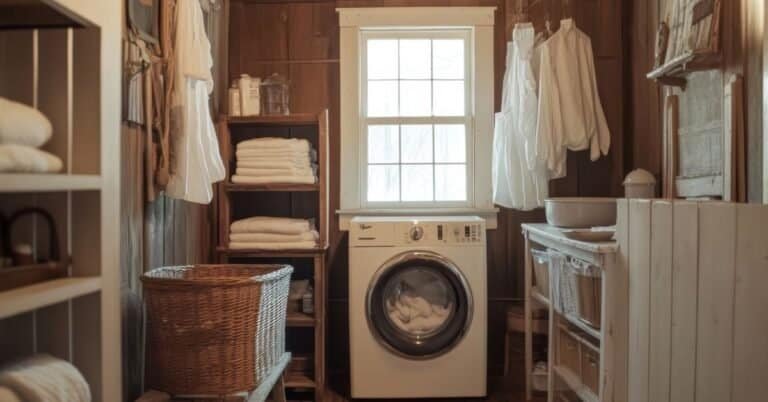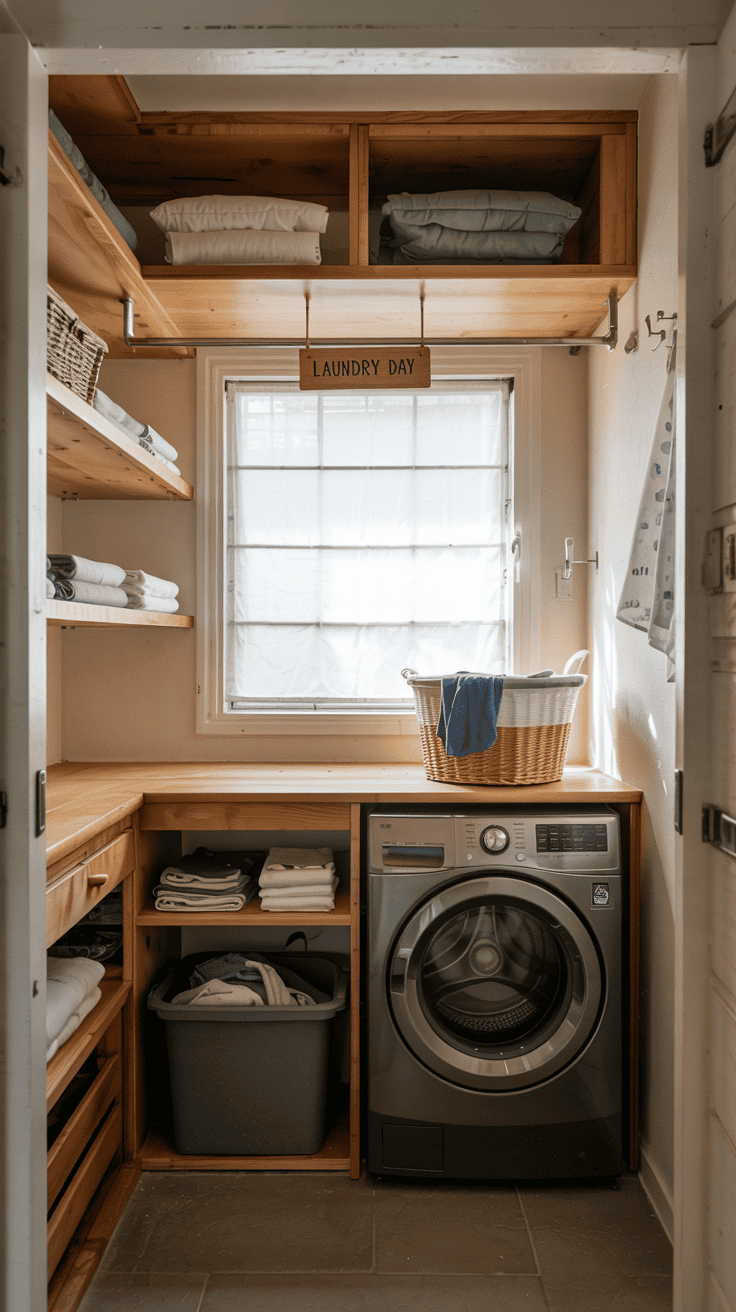This post shows The Ultimate Small Laundry Room Organization System!

Let me guess—you open your laundry room door and immediately want to slam it shut again? Yeah, I’ve been there. That chaotic mess of detergent bottles, random socks, and that pile of clothes you’ve been meaning to fold for three weeks (don’t worry, we’ve all got one).
Here’s the thing: small laundry rooms don’t have to be organizational nightmares. I learned this the hard way after spending way too many Saturday mornings hunting for matching socks like some sort of domestic detective. But once I cracked the code on maximizing every square inch, laundry day actually became… dare I say it… manageable?
Assessing Your Space and Needs

Before you start buying every cute basket you see on Pinterest, take a step back. Measure your space first—and I mean everything. Width, height, depth, and those weird little corners that seem designed to collect lint.
I learned this lesson after buying three “perfect” storage solutions that didn’t fit anywhere. Grab a measuring tape and sketch out your space—even a rough drawing on paper helps. Document where your outlets are, how your doors swing, and any obstacles like water heaters or utility panels.
Walk through your family’s laundry routine honestly. Do you have a soccer player who goes through three uniforms a week? A toddler who treats every meal like a Jackson Pollock painting? Your organization system needs to match your chaos level.
Track your laundry for a week. How many loads do you actually do? What types of stains do you deal with most? Where does clean laundry tend to pile up? This intel is gold when planning your system.
Most small laundry rooms fail because they’re organized for the family someone wishes they had, not the family they actually have. That Instagram-worthy setup with pristine white baskets? It won’t survive your reality if you’ve got three kids under ten.
Set realistic goals based on your lifestyle. If you’re barely keeping up with the washing, don’t create a system that requires folding everything Marie Kondo-style. FYI, there’s no shame in planning for maximum mess—it’s just realistic 🙂
Vertical Storage Solutions

Time to think like a skyscraper architect. Your walls are prime real estate, so use them!
Wall-mounted shelving above your washer and dryer creates instant storage for detergents, fabric softeners, and all those mysterious laundry products that somehow multiply overnight. I installed floating shelves and suddenly had space for everything—even those bulk-size detergent bottles from Costco.
Here’s what works best: Install shelves at least 18 inches above your appliances so you can still open the lids. Use brackets rated for the weight you’re planning to store—trust me, falling detergent bottles are not fun.
Pegboards are game-changers for small spaces. Mount one on any available wall space and customize it with hooks, baskets, and small shelves. Hang your measuring cups, stain removal brushes, lint rollers, and even a small basket for dryer sheets. Everything has a home, and you can see it all at a glance.
Over-washer/dryer cabinets maximize vertical space but require careful planning. Measure twice, install once—seriously. You need proper clearance for appliance doors and service access. If you’re renting, look for freestanding cabinet units that don’t require permanent installation.
Door-back organizers work magic too. That space behind your laundry room door? It’s perfect for cleaning supplies, extra hangers, or a shoe organizer filled with small items like stain sticks and lint rollers. Every square inch counts when you’re working with limited space.
Smart Sorting and Workflow Systems

Here’s where the magic happens. Create a sorting system that actually works for your family—not the Pinterest-perfect version that requires color-coding everything by thread count.
I use three simple bins: darks, lights, and “deal with this later” (yes, that’s an official category). Each family member gets their own designated spot for dirty clothes. No more mystery piles or playing detective with whose underwear this is.
Multi-bin sorting stations don’t have to be expensive. I found a three-section laundry sorter at a thrift store and it’s been a game-changer. If floor space is tight, wall-mounted sorting bags work just as well. Label everything clearly—pictures work great for kids who can’t read yet.
Set up a pre-treating station right where you sort. Keep stain remover, a small brush, and maybe a spray bottle within arm’s reach. Deal with stains immediately instead of playing “guess that stain” three days later. Fresh stains come out easier than set-in ones—this isn’t rocket science, but we all forget it sometimes.
Color-coded systems work if your family will actually use them. I tried assigning each kid a specific colored basket, but honestly? They just threw everything wherever. Now I use one system everyone understands: dirty goes here, clean goes there, special care items go in the small basket.
The key is creating a flow: dirty clothes go in designated bins, get pre-treated if needed, then move to the washer. One direction, no backtracking. Your system should make sense even when you’re rushing to get a load in before school pickup.
Maximizing Hidden Storage

Ever noticed that weird gap between your washer and the wall? That’s not wasted space—it’s an opportunity! Slim rolling carts fit perfectly in these spots and can hold detergent, dryer sheets, or cleaning supplies.
I found a 6-inch-wide rolling cart that slides perfectly between my washer and the wall. It holds all my backup supplies and rolls out when I need to restock. Measure your gap first—these spaces are usually between 4-8 inches wide, and finding the right cart makes all the difference.
Look up—seriously. Ceiling-mounted drying racks that fold flat against the ceiling when not in use are brilliant for small spaces. I installed one and suddenly had room to air-dry delicates without sacrificing floor space. They’re especially great for apartment dwellers who can’t install permanent clotheslines.
Under-appliance storage is your friend too. Rolling drawers that slide under your washer or dryer can hold extra supplies, seasonal items, or even your emergency chocolate stash (hey, laundry day is stressful). Make sure your appliances have enough clearance and that you can still access maintenance panels.
Custom solutions don’t have to break the bank. A simple shelf between your appliances can hold baskets for each family member’s clean clothes. Built-in nooks around pipes or in awkward corners can become perfect spots for narrow storage towers.
Think three-dimensionally. That space above your door frame? Perfect for storing seasonal items. The area behind the door when it’s open? Great for a thin cleaning supply cabinet.
Time-Saving Organization Hacks

Let’s talk about batch processing—the secret weapon of organized families. Designate specific days for specific types of loads. Towels on Tuesday, colors on Thursday, whatever works for your schedule.
Here’s why this works: you’re not constantly switching between different products and settings. All the towels get the same treatment, all the delicates get gentle care, and you develop a rhythm that makes everything faster.
Create grab-and-go stations for daily needs. A small basket with dryer sheets, stain remover, and fabric softener sheets means you’re not hunting around every single load. I keep mine right on top of the dryer—everything I need is within arm’s reach.
Here’s a game-changer: emergency laundry kits. Small containers with just enough detergent for one load, plus a dryer sheet and maybe a stain stick. Perfect for when someone suddenly remembers they need their uniform clean by tomorrow morning. Toss the kit in a basket and you’re good to go.
Pre-portioned supplies save time and reduce waste. I use small containers to portion out fabric softener for the week. No more standing there wondering if that’s enough or too much—just grab and pour.
Make it kid-friendly. Lower hooks for their clothes, labeled bins they can actually read, and systems simple enough that even your teenager can’t claim they “don’t know where things go.” Visual guides work wonders—take photos of how things should look and tape them inside cabinet doors.
Timer systems prevent forgotten loads. Set phone alarms or use a kitchen timer to remind you when loads are done. IMO, nothing wastes more time than rewashing clothes that sat wet too long.
Maintenance and Sustainability

IMO, the best organization system is one you’ll actually maintain. Weekly maintenance beats monthly overhauls every single time.
Spend five minutes each week putting things back where they belong. I do this while waiting for the washer to finish—it’s the perfect amount of time to reset everything. Make it a habit, not a chore. Play your favorite song and tidy up while it plays.
Teach your family the system. Everyone who creates laundry should know how to maintain the organization. Yes, even the kids. Especially the kids. Create simple checklists they can follow, and maybe even add some incentives for keeping things organized.
Schedule monthly reviews of what’s working and what isn’t. Your needs change, and your system should adapt. Maybe those cute small baskets aren’t big enough anymore, or that upper shelf is too high for daily use. Don’t be afraid to adjust.
As your family changes, your system should adapt too. That toddler bin might become a sports equipment station, and that’s perfectly fine. Flexibility beats perfection every time. The goal is making your life easier, not creating a museum display.
Budget-friendly updates keep things fresh. Swap out worn labels, add new hooks as needed, or reorganize based on seasonal changes. Sometimes just moving things around can make everything feel new again.
Keep a running list of what’s working and what isn’t. Take notes on your phone when something frustrates you—you’ll remember to fix it during your next organization session. Small tweaks often make the biggest difference in daily usability.
Conclusion
Look, I’m not going to pretend that organizing your laundry room will suddenly make you love doing laundry (though it might help). But it will definitely make the process less painful and more efficient.
Start small, think vertical, and create systems that work for your actual family—not the one you see in magazines. Your future self will thank you when you’re not standing in your laundry room at 10 PM, desperately searching for your kid’s favorite shirt.
Remember: progress over perfection. Even if you just implement one or two of these ideas, you’re already ahead of the game. And hey, if all else fails, at least you’ll know exactly where to find that emergency chocolate 🙂

This post shows The Ultimate Small Laundry Room Organization System!







